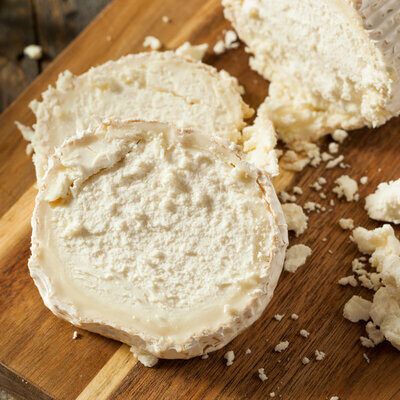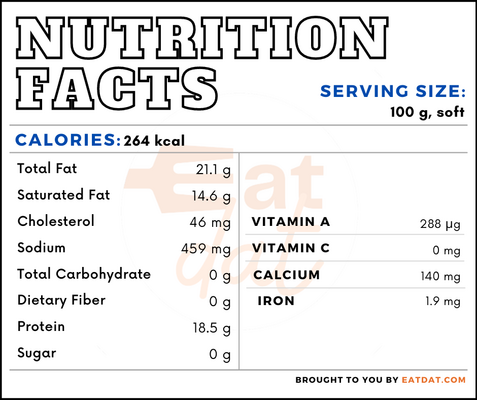
Goat Cheese
What is Goat Cheese?
Goat cheese is a type of cheese made from goat’s milk. It comes in a variety of different styles, including soft and creamy, crumbly, and hard and aged.
- Goat cheese is made in different ways around the world, with one of the more well-known being feta cheese.
- This cheese is usually white in color and has a tart, earthy flavor that comes from fatty acids such as caproic and caprylic present in goat’s milk.
It is a great cheese to use in sandwiches, bruschetta, and crostini. Also, goat’s cheese is used extensively in salads. It may be added to many other dishes to give that unique tart flavor.
The most popular types of goat cheeses include:
- Feta (Greece)
- Ricotta (Italy)
- Gouda (Netherlands)
- Bûche de Chèvre (France)
- Selles-sur-cher (France)
- Murcia al Vino (Spain)
- Fromage Frais (Belgium)
- Caprine (Italy)
- Humboldt Fog (USA)
- Garrotxa (Spain)
- Bleu de Chèvre (France)
- Halloumi (Cyprus)
- Tomme d’Aydius (France)
- Saint-Maure de Touraine (France)
- Crottin de Chavignol (France)
Origin of goat cheese
Goats were the first animals to be domesticated for their milk around 9,000 years ago. Domestication was first practiced in the region that is now Iran. After that, goats were brought by the Moors to France in the 8th century. Goat cheese originated in these regions and later spread through other regions of the world through travel and trade. Nowadays, the popularity of goat cheese is increasing in the United States due to the rise of popularity in the Mediterranean Diet.
Nutrition
Nutritional profile for goat cheese (100 g, soft):

Goat cheese is rich in calcium, phosphorous, sodium, vitamin A, and retinol. Also, it contains magnesium, potassium, folate, choline, carotene, vitamin D, and fatty acids in decent quantities. Regular consumption of cheese may help combat inflammation, prevent osteoporosis and arthritis, decrease the risk of fractures, and manage obesity. Additionally, the linolenic acid in the cheese may prevent diseases such as cardiovascular diseases and diabetes and improve the blood profile. Furthermore, it helps in managing the plasma levels and helps in preventing inflammation.
Commercial production
The largest producer of goat cheese is South Sudan, followed by France, Greece, Spain, Niger, Tajikistan, Mexico, Uzbekistan, Afghanistan, Iran, China, Yemen, Syria, Ukraine, and Morocco. However, most of the world’s goat cheese is consumed in Asia.
To produce goat cheese, the goats are milked and then the milk is pasteurized for soft cheeses. After that, once cooled, bacteria culture is added to the milk, which allows it to curdle and gives it the acidic cheese flavor. Also, rennet is added. Then, the curds are formed and pressed into molds, which are periodically pressed to drain off all extra liquid. Finally, the cheese is stored in barrels, salted, and allowed to age.
Goat cheese recipes
This cheese adds flavor to different dishes, but it is also prized for its unique texture. It may be added to salads, soups, vegetables, rice, pastas, pies, and sandwiches. Also, it can be baked and served with olive oil on its own, or eaten fresh with bread. Here are a few recipes:
- Baked Goat Cheese
- Mushroom Cheesy Pasta
- Cheese Honey Poppers
- Herb-Marinated Goat Cheese
- Carpaccio
- Mushroom and Spinach Scramble
- Grilled Apricots
- Onion and Cheese Tartlets
- Lentil Soup with Cheese Toast
- Bruschetta
- Potato Appetizers
- Cheese Balls
- Salade de Chêvre Chaud
- Lentil Salad
- Pastitsio
- Polenta
FDA regulations
The FDA has separate definitions for many different types of cheeses that are popular. However, it currently offers no standard of identity for goat cheese.
References
Rozenberg, Serge et al. “Effects of Dairy Products Consumption on Health: Benefits and Beliefs–A Commentary from the Belgian Bone Club and the European Society for Clinical and Economic Aspects of Osteoporosis, Osteoarthritis and Musculoskeletal Diseases.” Calcified tissue international vol. 98,1 (2016): 1-17. doi:10.1007/s00223-015-0062-x, https://www.ncbi.nlm.nih.gov/pmc/articles/PMC4703621/
Santurino, Cristina et al. “Consumption of Goat Cheese Naturally Rich in Omega-3 and Conjugated Linoleic Acid Improves the Cardiovascular and Inflammatory Biomarkers of Overweight and Obese Subjects: A Randomized Controlled Trial.” Nutrients vol. 12,5 1315. 5 May. 2020, doi:10.3390/nu12051315, https://www.ncbi.nlm.nih.gov/pmc/articles/PMC7285099/
